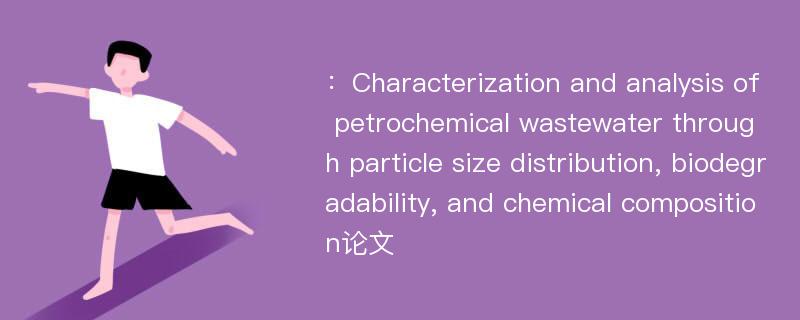
本文主要研究内容
作者(2019)在《Characterization and analysis of petrochemical wastewater through particle size distribution, biodegradability, and chemical composition》一文中研究指出:The centralized treatment method is a widely used form of wastewater treatment that tends to be less effective at removing toxic substances. Therefore, a detailed analysis of the composition of wastewater can provide important information for the design of an effective wastewater treatment process. The objective of this paper was to investigate particle size distribution(PSD), biodegradability, and the chemical composition of the petrochemical wastewater discharges. For this purpose, this project selected the petrochemical wastewater and treated wastewater of China National Offshore Oil Corporation Zhongjie Petrochemical Co, Ltd. as the analysis objects.The step-by-step filtration method, along with a molecular weight classification method, was selected to build the chemical oxygen demand(COD) and biochemical oxygen demand(BOD) fingerprints of petrochemical wastewater and treated wastewater. The results showed that the main pollutants were settleable particles in petrochemical wastewater, which contributed to over 54.85% of the total COD. The colloidal particles with particle sizes in the range of 450–1000 nm had the highest COD value in the treated wastewater, which contributed34.17% of the total COD of treated wastewater. The results of the BOD analysis showed that the soluble fractions were the main reason that treated wastewaters did not meet the treatment standards. Tests on the organic compounds in petrochemical wastewater found that there were mainly linear paraffins, branched paraffins, benzene series compounds, and some plasticizers in the influent of the petrochemical wastewater. The most abundant pollutants in treated petrochemical wastewater were the adjacent diisobutyl phthalate and the linear alkanes.Fourier transform infrared(FTIR) transmission spectroscopy analysis showed that the settleable particles of petrochemical wastewater and membrane bioreactor(MBR)-treated wastewater contained multiple types of organic substances. The results also indicated that removing the oil-settleable substances, the colloidal particles(450–1000 nm), and the soluble organics will be necessary for the treatment of petrochemical wastewater.
Abstract
The centralized treatment method is a widely used form of wastewater treatment that tends to be less effective at removing toxic substances. Therefore, a detailed analysis of the composition of wastewater can provide important information for the design of an effective wastewater treatment process. The objective of this paper was to investigate particle size distribution(PSD), biodegradability, and the chemical composition of the petrochemical wastewater discharges. For this purpose, this project selected the petrochemical wastewater and treated wastewater of China National Offshore Oil Corporation Zhongjie Petrochemical Co, Ltd. as the analysis objects.The step-by-step filtration method, along with a molecular weight classification method, was selected to build the chemical oxygen demand(COD) and biochemical oxygen demand(BOD) fingerprints of petrochemical wastewater and treated wastewater. The results showed that the main pollutants were settleable particles in petrochemical wastewater, which contributed to over 54.85% of the total COD. The colloidal particles with particle sizes in the range of 450–1000 nm had the highest COD value in the treated wastewater, which contributed34.17% of the total COD of treated wastewater. The results of the BOD analysis showed that the soluble fractions were the main reason that treated wastewaters did not meet the treatment standards. Tests on the organic compounds in petrochemical wastewater found that there were mainly linear paraffins, branched paraffins, benzene series compounds, and some plasticizers in the influent of the petrochemical wastewater. The most abundant pollutants in treated petrochemical wastewater were the adjacent diisobutyl phthalate and the linear alkanes.Fourier transform infrared(FTIR) transmission spectroscopy analysis showed that the settleable particles of petrochemical wastewater and membrane bioreactor(MBR)-treated wastewater contained multiple types of organic substances. The results also indicated that removing the oil-settleable substances, the colloidal particles(450–1000 nm), and the soluble organics will be necessary for the treatment of petrochemical wastewater.
论文参考文献
论文详细介绍
论文作者分别是来自Chinese Journal of Chemical Engineering的,发表于刊物Chinese Journal of Chemical Engineering2019年02期论文,是一篇关于,Chinese Journal of Chemical Engineering2019年02期论文的文章。本文可供学术参考使用,各位学者可以免费参考阅读下载,文章观点不代表本站观点,资料来自Chinese Journal of Chemical Engineering2019年02期论文网站,若本站收录的文献无意侵犯了您的著作版权,请联系我们删除。
